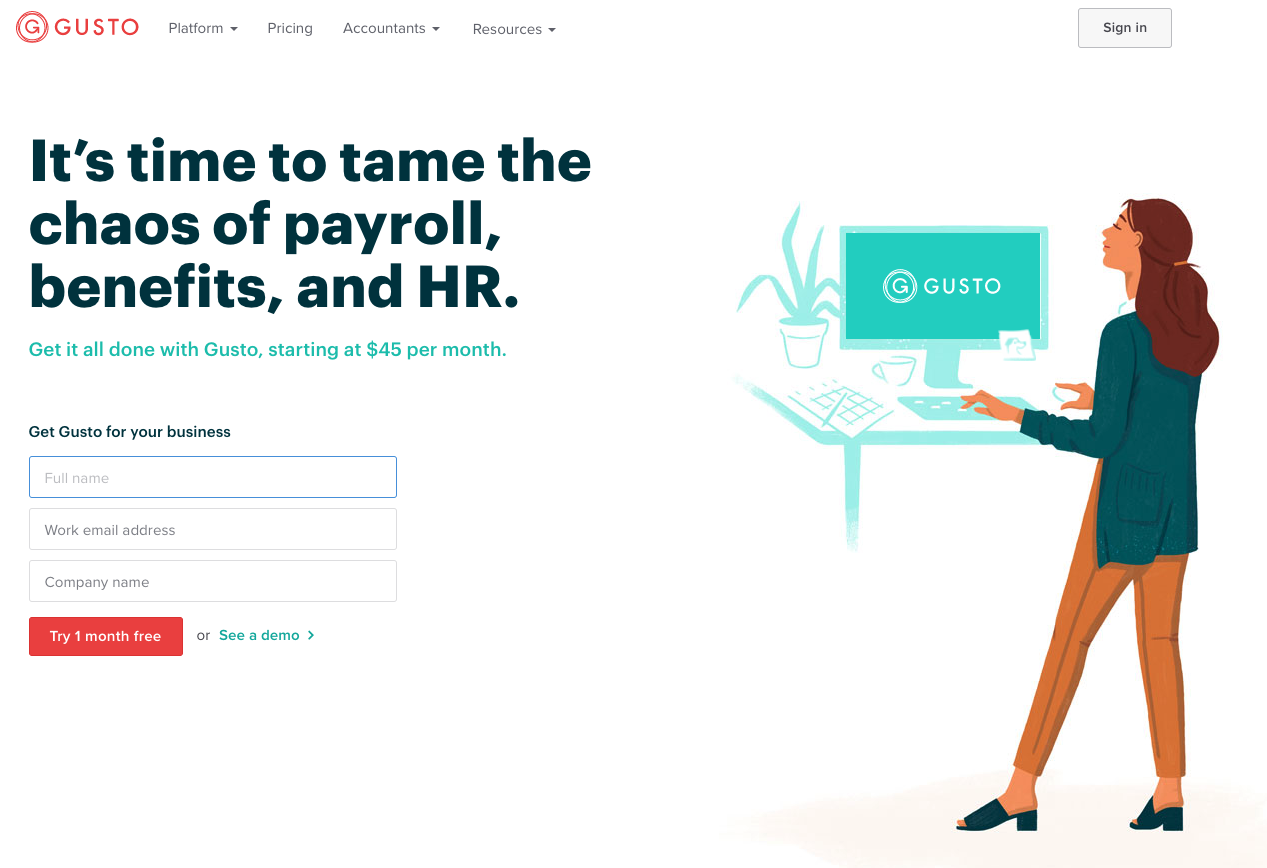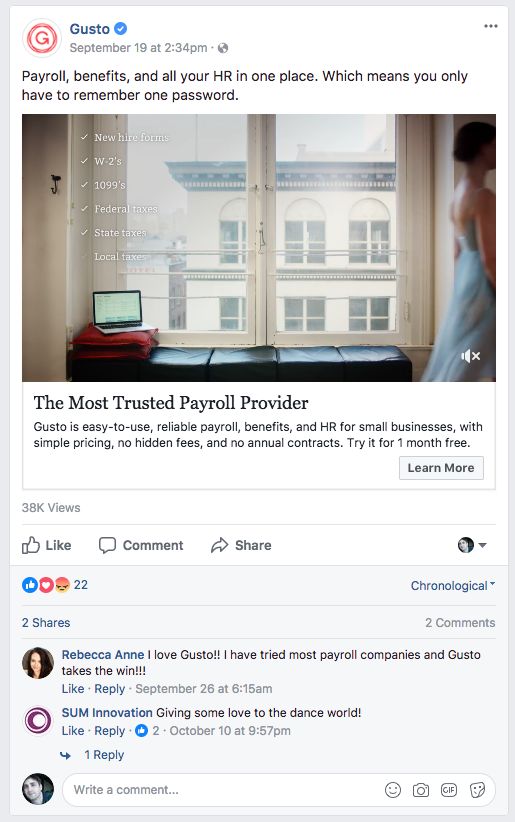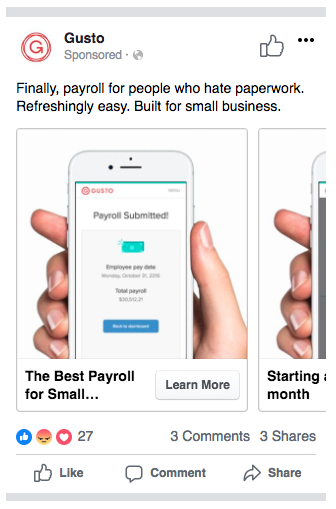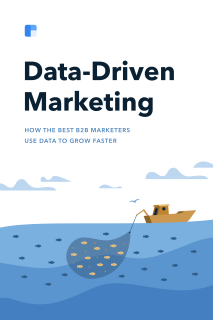Chapter 11
17 minutes
Social Advertising for B2B

Soso Sazesh CEO and Founder of Growth Pilots
B2B marketers are quick to overlook paid advertising on Facebook and other social platforms, often thanks to these thoughts:
- My customers aren’t on social, and if they are, they’re in ‘consumer mode,’ not shopping for business tools.
- I can’t do scalable marketing on social because the audience isn’t big enough.
- I’ll get bad leads and low-value business from paid social.
- Even if Facebook ads work at first, it’ll become too expensive to be profitable as I scale up that channel.
At Growth Pilots, my team and I specialize in both paid social and paid search advertising, so we’ve seen firsthand how reluctant B2B SaaS companies can be to shift some of their attention and budget from Google ads to Facebook. Many of them find that social is worth a second look as a scalable acquisition channel. It’s not for everyone, but we can learn from countless successful B2B implementations to see where it does work.
In this chapter we’ll share the story of Gusto, an all-in-one platform for payroll, benefits, and HR serving over 40,000 small businesses. We helped grow their customer base with the help of social ads while they were going through typical B2B SaaS milestones; we’ve reached more than 10 million people over the course of about two years, and served over 26 million impressions. We’ll also show you our own real-world campaign learnings and dispel misconceptions about social ads with a primer on how they work.
We’ll focus on Facebook ads because of their large reach and advanced targeting options, but the high-level principles apply for platforms like LinkedIn as well.
Ready? Let’s meet Dan Davidow, acquisition lead at Gusto.
Why Gusto decided to try paid social advertising
Gusto builds HR, benefits, and payroll tools to make it easier for small businesses to do HR. They were founded in 2013 and are scaling quickly, with about 450 employees just four years in.
Small businesses, particularly those with under 50 employees, are underserved by payroll software. “Large incumbents are missing features that small businesses need, or they’re focusing on larger SMBs,” says Dan. “My team’s goal is to identify as many small businesses to help as possible. We run paid media campaigns, optimize them, and measure performance across the marketing organization.”

Previously, Gusto allocated most paid acquisition efforts toward businesses that were just getting started, primarily those that had less than 10 employees. As Gusto matured and built additional functionality, such as the ability for businesses to provide employees with health insurance, their target market expanded. With the new functionality and larger target market, they decided to shift their paid acquisition focus to include US businesses with 10–50 employees.
So Dan’s team faced several core marketing challenges:
Scale - The US has millions of small businesses. How can they reach those with <10 employees, and now, those with <50 employees as well?
Segmented purchase funnels - Larger, more profitable potential customers deserve more attention from sales and customer service during the purchase process. How can they delineate customer tiers, target them with different ads, and optimize CPCs for each one?
Sales complexity - It requires quite a bit of education and time to get a business to enroll with a new payroll software, especially those that already have payroll providers, which they call “migrators and switchers” and are encountering more often, now that they’re going for larger SMBs. This increases the complexity of the buyer funnel. “Migrating your payroll is not fun,” says Dan. “How do we encourage folks who are suffering with ADP or Paychex to migrate?”
As a marketing channel, social advertising has the capability to address these challenges, which are relatable for many of the growing SaaS companies you’ve read about in Data-Driven Marketing.
“Our audience engages in search, but we also felt like they were on social. So we began experimenting and our early tests showed good results.” They evolved the channel from there, eventually running a number of successful direct response and branding campaigns on Facebook, LinkedIn, and more.
Let’s look at how those campaigns fit into Gusto’s overall marketing funnel.
Social ads in the marketing funnel
Social ads have a function at the top and bottom of the typical B2B SaaS marketing funnel.
Up top, social ads are great for education, awareness, and brand building. This is because Facebook and LinkedIn have huge reach (with 200M+ people in the US on Facebook at the time of writing), so it is possible to drum up interest in a broad swath of people.
Compared with paid Google search ads, paid social platforms are a better way to generate awareness. This is because people who are searching Google for keywords related to your business are actually quite limited. You can bid on those keywords and serve ads to convert them, but if you try to scale up and run a broad awareness campaign on B2B keywords, the costs typically start to become prohibitive. Save those search dollars for bottom-of-the-funnel conversions.
Generating awareness on social platforms often goes hand in hand with good content marketing, especially if you’re in a business where people need lots of consideration time before buying your services. You can use Facebook to distribute educational content like articles, ebooks, webinars, and other resources to pique interest and send them to your website to poke around. And once you’ve captured some email addresses on your website, or visitor identities with tools like the Facebook pixel or Clearbit Reveal, you can identify the best leads and remarket to them until they convert.
Facebook ads can also be appropriate at the bottom of the funnel for direct-response conversion campaigns. With Facebook pixel event tracking, you can track whether a website visitor submits an email address, adds an item to their cart, makes a purchase, and more—then attribute it directly back to the Facebook ad they came from.
It takes quite a bit of time and education for a company to choose Gusto, especially if they’re a switcher or migrator, and they found that social ads have different uses at the top and at the bottom of their marketing funnel. To complicate things, the pool of actual decision makers, people in Payroll, is quite small. It is difficult to target them and still reach many businesses at scale. So Gusto decided to market to payroll employees’ colleagues first.
Gusto generates awareness for their brand with Facebook ads shown to to all employees at eligible small businesses, which drives traffic to the Gusto website and landing pages. They capture the best leads, help non-decision makers spread the word in their companies, get closer to identifying decision makers, and remarket to them later with more conversion-focused campaigns.
“We use remarketing to accelerate demand,” Dan says. “We know that people are doing comparison shopping. Remarketing helps us stay top of mind during the decision-making process, and if prospects aren’t there yet, we use remarketing to take them through a journey and show them what’s possible.”
To summarize the strategy:
- Top of Funnel: Prospect. Cast a wide net. Educate all employees at prospective customer businesses.
- Middle of Funnel: Get non-decision makers to sign up, spread the word to decision makers, and drive decision-maker traffic to the site to build a remarketing audience.
- Bottom of Funnel: Remarket to decision makers aiming at conversion.
Conversion event tracking
So, how do you know whether your Facebook ads are effective? You want to track more than just “clicks” on the ad—you want to know whether they actually encourage lead captures and purchases, and if so, which types of ads should get the credit?
Facebook pixel event tracking lets you tie ads to specific events that happen on your website, like lead captures, visits to your Case Studies page, “add to cart” actions, purchases, and more.
For us, the trick was to map the key business metrics that are important to Gusto and map them to what we can track in Facebook—because then we got the benefit of being able to optimize for the Facebook algorithm and track important customer actions in real time.
Tip: Pixel the hell out of your website and track as many events as you can. Even if you only care about a subset of them right now, having the data available may be useful in the future, and it doesn’t hurt to collect it.
These three events mapped to important customer milestones at Gusto.
- Lead capture: Someone on the Gusto website submits their email address to sign up for a (free) account and becomes a lead.
- “Add employee”: That lead adds an employee to their account—a major step in being able to actually run payroll and pay that employee.
- “Run payroll”: The account holder runs payroll to pay an employee. This is considered the final conversion step because at that point, Gusto charges a fee and the lead becomes a paying customer.
Initially, the main success metric for Facebook ads was how many people hit Milestone 3: “Run Payroll.” But we quickly learned that it wasn’t well suited as the only key success metric for Gusto, because a lot of time elapses between a user seeing a Facebook ad, deciding to sign up, adding employees, and actually running payroll. We added Milestones 1 and 2 to understand activities a little higher in the funnel.
Segment and target social ads
Even though ads on Facebook have a huge reach, they can still be targeted. Facebook has a number of options for targeting customer segments.
- Core audiences: Select your desired age, location, interests, behaviors, etc.
- Custom audiences: A company can upload a list of customers or a list of leads. You can remarket directly to that specific lead list on Facebook, or those uploaded customer and lead lists can be used to create audiences that look like them (“Lookalikes”).
- Lookalikes: Facebook will find people in your country that look like your set of source customers or leads. Lookalike audiences can be based on pixel-based audiences or custom audiences.
Custom audiences and Lookalike audiences are powerful marketing tools, and they allow for different marketing to different customer segments.
For example, let’s say you have Segment A and Segment B in your customer base—Segment A consists of your most profitable customers, who deserve sales support, and Segment B has customers that are less profitable and should be self-serve. You can upload those two lists as two custom audiences and create two Lookalike audiences. The Lookalike audiences will then mirror only Segment A or Segment B rather than your general customer population. (And if there’s an overlap, you can set rules to exclude customers from one group if they’re in the other.)
Then, you can serve Lookalike A and Lookalike B different Facebook ads and landing pages that cater to their unique needs. You can also measure the success metrics of the two audiences separately and optimize creatives, CPCs, and more for each segment. The same can be done with verticals, geographies, and other commonalities between customer groups.
Gusto used this strategy as they started to go upmarket and target larger SMBs. They ran two ad campaigns for two Lookalike audiences:
Segment A: <10 employees
Segment B: 10 or more employees
It was very difficult to distinguish the the two company sizes for building segmented audiences on Facebook. In Gusto’s case, we had a conversion pixel fire based on how many employees a given company entered in the signup/lead form on Gusto’s website. This allowed us to:
- Easily track if we were effectively targeting the intended audience and measure performance on a customer segment level.
- Build two separate, custom audiences based on company size. This allowed us to do more targeted remarketing as well as easily generate Lookalikes built on top of these two distinct audiences.
Campaigns for Segment A looked different from campaigns for Segment B, with different creative and copy, landing pages, unique tests, and of course, sales support.
This audience-appropriate marketing campaign helped Gusto get higher conversions in both segments because of the targeted messaging and appropriate support levels. They were also able to track how many companies from each group converted, which let them calculate the profitability of the social ads for each segment and adjust their budgets accordingly.
Test creatives
Getting creatives for different segments in your social advertising requires experimentation and finessing over time.
At Growth Pilots, we have a cadence of testing new creatives weekly or biweekly and we optimize the bids and budgets at least twice weekly. And it’s important to note that Facebook ads don’t change on a dime. Changes to accounts will be felt over a few days (unlike other networks). It’s always an evolving environment. You need to be vigilant over a couple days to make sure it looks good.
Common types of tests for social ads include:
Placements: The spots on Facebook where you run your ads are called “placements”—see here for a list. Form factors are different depending on whether the ad appears in the News Feed, Instagram, Messenger, etc. “We’re always trying to match the context to the content better, and find the best context for customer engagement,” says Dan.
Mobile versus desktop: Another way to test ad placements.
Creative type: We often test between ads that feature screenshots of a product, or ones that look more like an aspirational lifestyle ad.
Content: Educational content like webinars, whitepapers, eBooks, and testimonials can all be tested. Optimizing toward different parts of the funnel: Track conversion events and market to people based on how far along they got in your funnel.
Time of day: A potential Gusto payroll customer would probably be less likely to be in a buying mindset at 5 p.m. on a Saturday compared to 10 a.m. on a Tuesday.
CTA’s: Facebook ads come with buttons that serve as calls-to-action. The buttons have preset text options, like “Buy Now.”
“Learn More” is the CTA we’ve often used for Gusto. Others, like “Buy Now,” didn’t feel appropriate for the long B2B sales cycle and their focus on ongoing services rather than one-time purchases. So we supplemented “Learn More” with other CTA-type text in the actual copy of the ad, such as “Try 1 Month Free” and “Try Gusto Free!”
Desktop News Feed Placement

A Gusto Facebook ad with placement in the desktop newsfeed.
Mobile News Feed Placement

A Gusto Facebook ad with placement in the desktop newsfeed.
When it comes to conversion campaigns, “we’ve found product-driven messaging to be the most effective. We need to make it clear what value-add Gusto offers,” says Dan. “Particularly when a prospect looks at one of our creatives, they should walking away knowing how we can help their business.”
Gusto has also tested a successful branding campaign using video ads that featured actress Kristen Schaal. “We distributed the ads on YouTube, Facebook, and LinkedIn, and we got thousands and thousands of people to learn about Gusto through that campaign,” says Dan.

Gusto: “Password” • For HR People Who Do Everything
The idea was to create a general audience that had engaged with the Gusto brand through video campaigns, and then remarket to them down the funnel based on their level of engagement.
A key success metric was how much of the video a prospect watched (did they complete 25%? 90%?). Then, at the end of the video, there was a link to click to a Gusto landing page with a quiz on it. Gusto tracked more events on that page, such as how many people finished the quiz or started but didn’t finish. Later, when they remarket to these folks, they can segment based on engagement.
Advertise on desktop without blowing through your budget
B2B SaaS companies typically convert their customers on desktop. Paid conversions rarely happen right on mobile after seeing an ad. Think of Gusto, Asana, CloudApp, and more—all their customers are more likely to successfully start using the product when they’re able to set it up on an actual desktop computer.
This is why B2B companies are willing to pay more for desktop social ads than mobile. And unfortunately, they typically cost much more on desktop. More than 90% of people access Facebook via mobile these days, so desktop inventory is already limited, but there’s competing advertiser demand for those lucrative desktop clicks.
We recommend that companies get around this by “prospecting” on mobile with top-of-funnel campaigns. They can capture traffic on their website, and then remarket to the best ones on desktop to get them to convert. Gusto used this technique. They used mobile ads to send traffic to a landing page and captured leads to build a more qualified desktop remarketing audience.
Track and attribute conversions
If you run Facebook ads, make sure to use Facebook Offline Conversions tracking to help you attribute purchases back to Facebook ads that helped along the way.
Offline Conversions make this possible even if you have a long sales cycle and/or prospects are jumping between desktop and mobile. In comparison, Facebook event tracking has a 28-day click-through attribution window, and for many B2B companies with long sales cycles, people will become paying customers long after that window has expired.
Facebook Offline Conversions let you integrate your CRM with Facebook via API and partner programs to automate the process of tying an offline conversion back to the Facebook ad that helped drive it. It can also be done manually by directly uploading CSVs of customer data to Facebook, although that’s more time-consuming.
By using UTM trackers, you can pass data about an ad, ad set, or campaign through an ad click, which allows you to tie revenue back to the ad, ad set, and campaign that drove the conversion. This allows you to not only optimize budget toward the campaigns that drive the most paying conversions, but also toward the ones that have the highest value. For campaigns that drive more revenue per ad click, you can afford to bid higher for each click. For campaigns that have a higher down-funnel conversion rate, you can afford to pay higher for each lead, knowing that a greater percentage of the leads you drive will convert.
This also lets you build audiences. When you have an automated upload of down-funnel offline converters, you can use it as the basis of a remarketing audience or as the basis for a source audience to build more Lookalike audiences. If you have a source audience of past converters, chances are the people who look most like them (based on Facebook data) will be much more likely to convert than a generic audience. This feedback loop improves your social advertising machine over time.
Final thoughts
If you haven’t tried social ads for your B2B business, we hope you’ll take another look and see whether it makes sense for your sales cycle, your audience, and your online marketing funnel.
You can start by testing simple campaigns: try to drive lead capture on your website by running a campaign to one audience.
If you get some traction, you can start to segment your audience into high- and low-value customers and change the creatives of your ads and landing pages accordingly. Make sure you define lots of Facebook pixel events on your site, so that as you get more advanced, you can track and remarket to people based on their tracked events on your site and platform—like Gusto’s “Add Employee” and “Run Payroll” actions.
Dan’s last words of wisdom for marketers looking into social? “Highlight your product’s value on your landing pages. Understand your audience and target them narrowly. Optimize relentlessly. Focus and emphasize remarketing. And do Lookalikes.”

